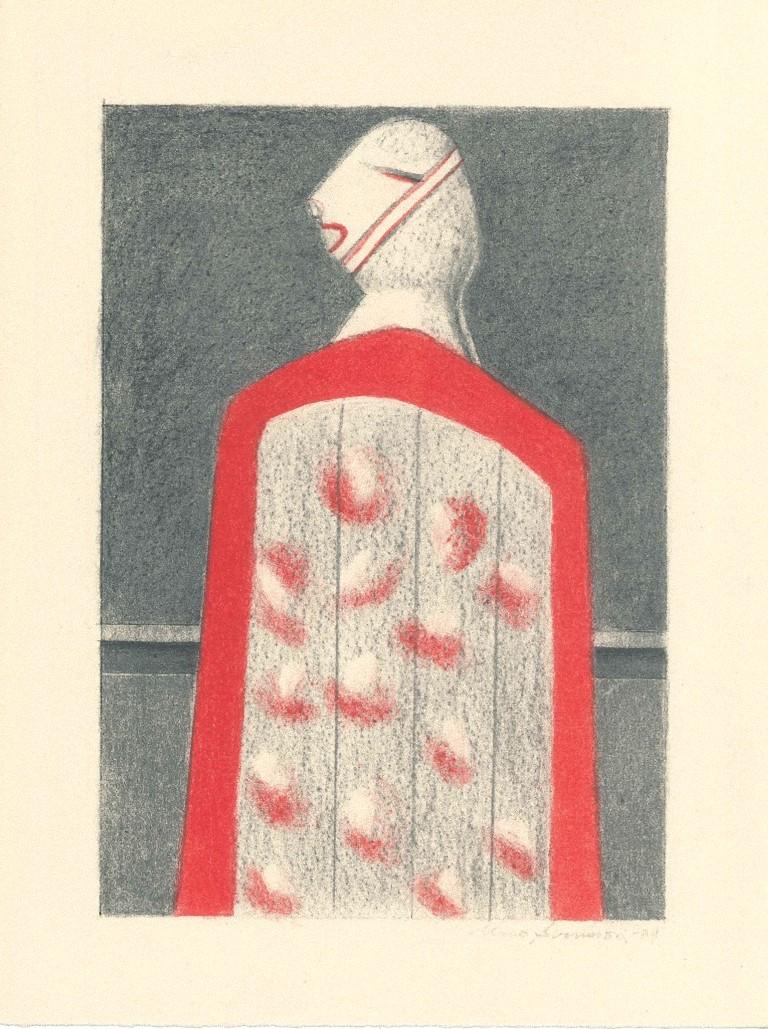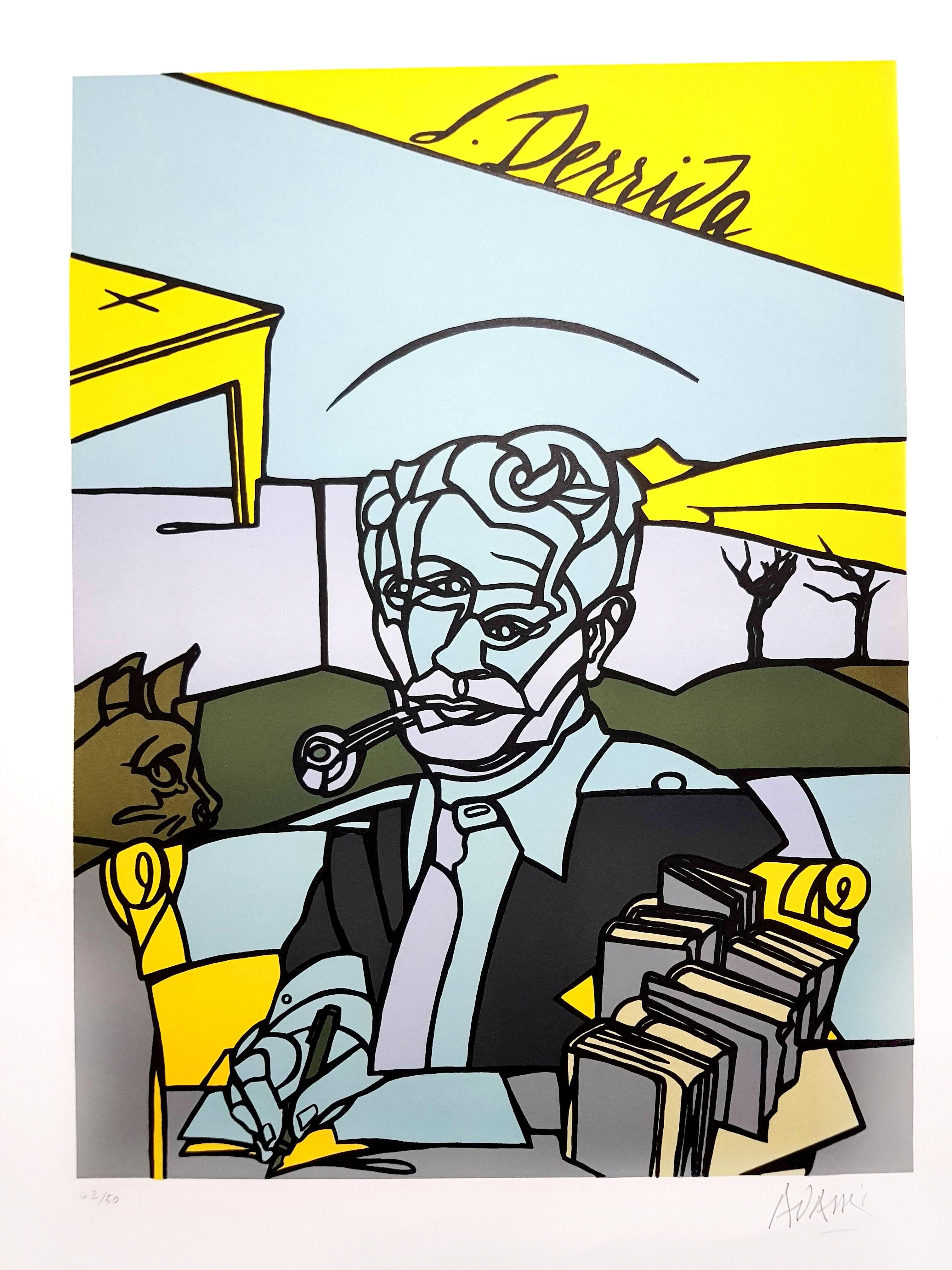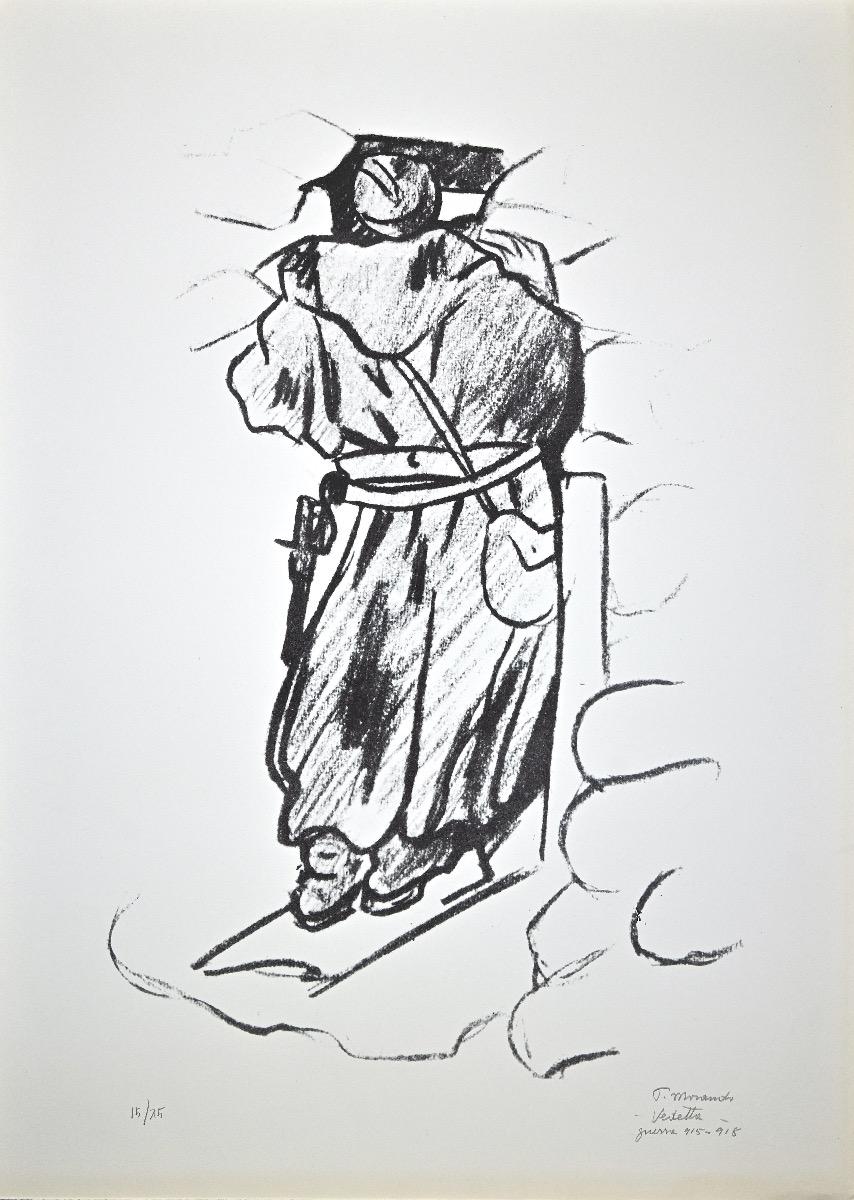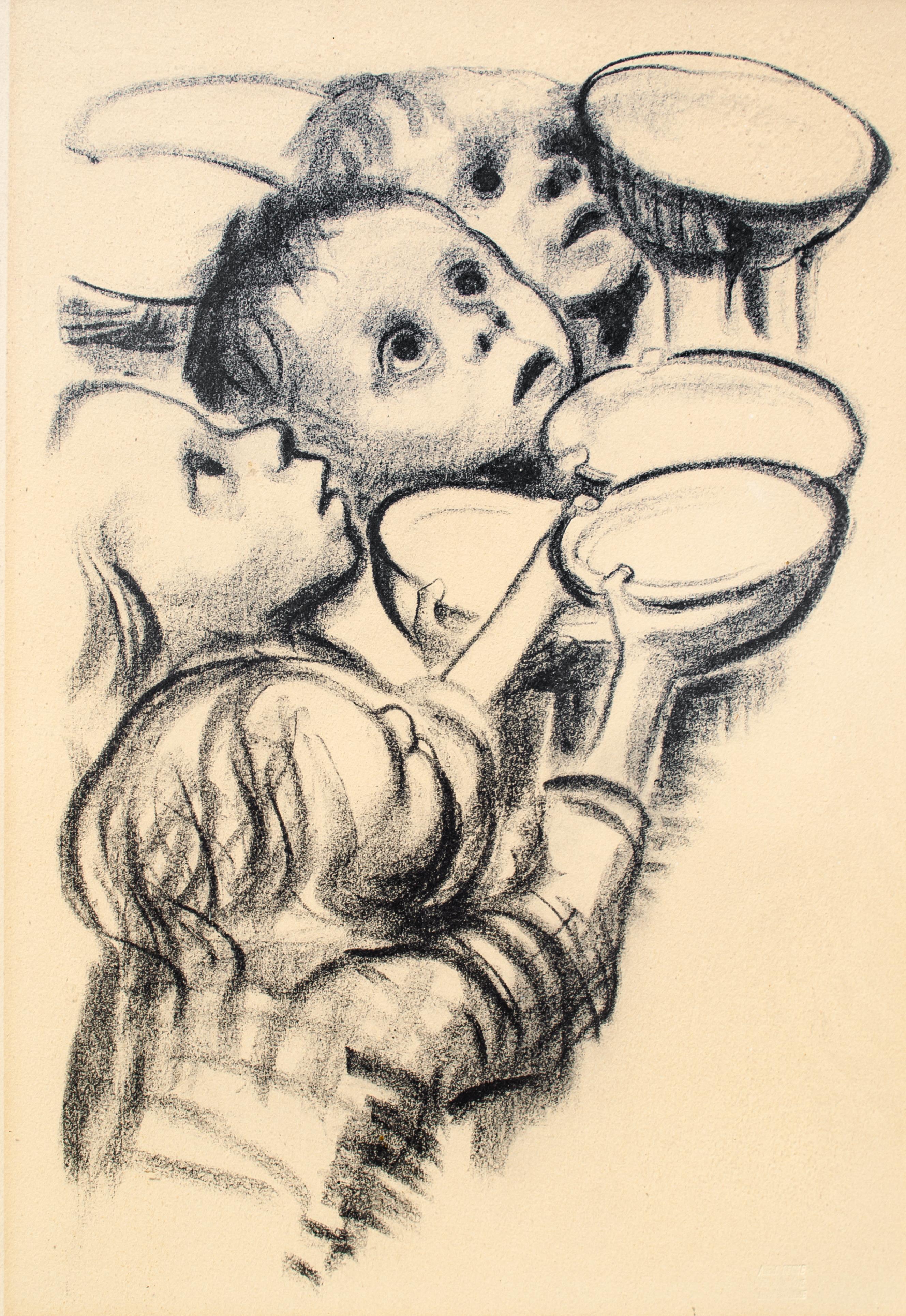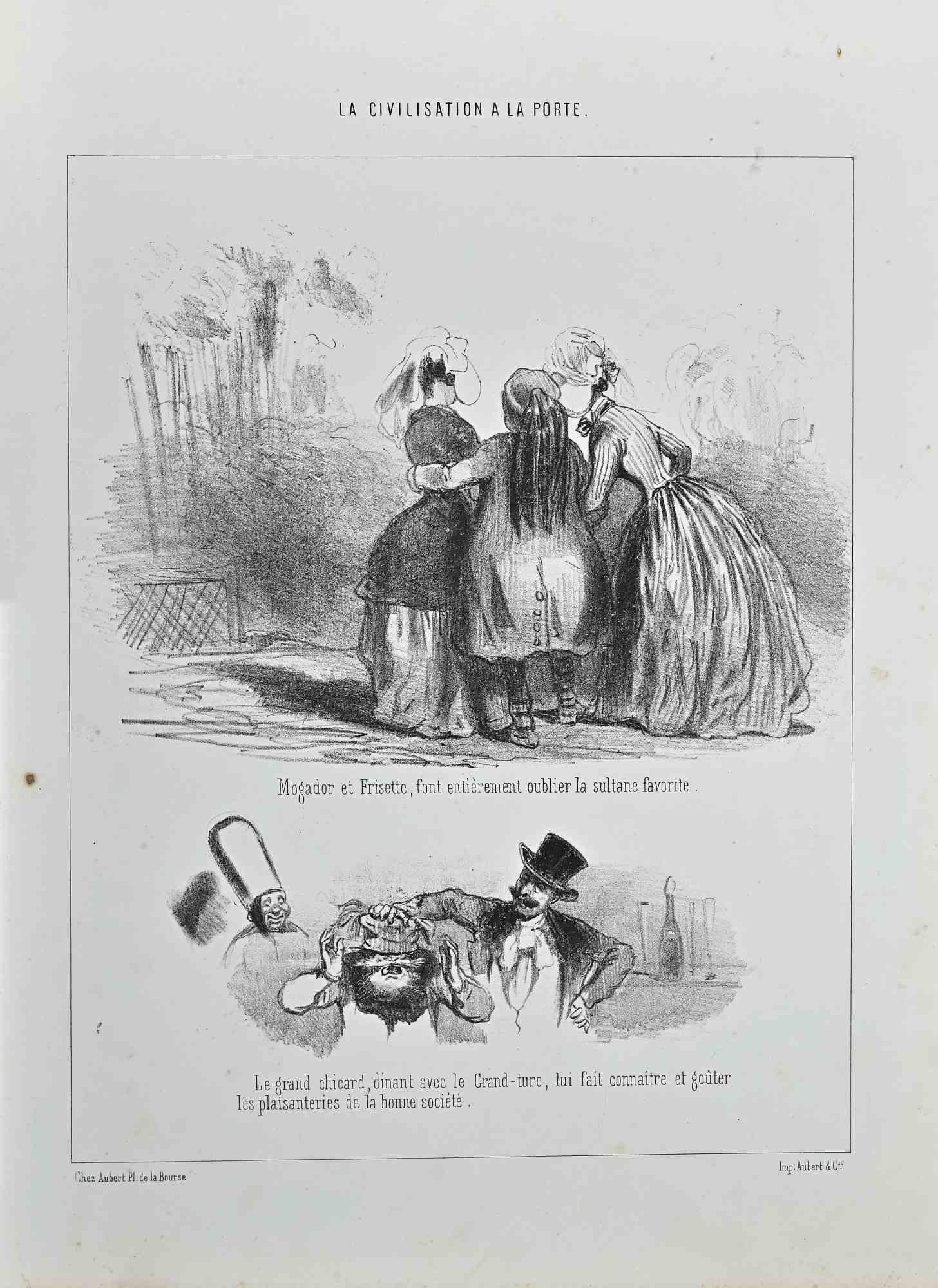Items Similar to Woman with Hat
Want more images or videos?
Request additional images or videos from the seller
1 of 7
Franco GentiliniWoman with Hatc. 1960
c. 1960
About the Item
This is an original color lithograph on wove paper by Roman Italian artist Franco Gentilini (1909 - 1981) entitled "Woman with Hat." It was created circa 1970 and is hand signed in pencil by the artist. The image size is 20 in. x 15.75 in. and the artwork is framed in a custom gold frame. In excellent condition.
Franco Gentilini worked as a ceramist in Faenza and collaborated with Giovanni Romagnoli and Giorgio Morandi in Bologna. He took part in numerous editions of the Venice Biennale, beginning with the acceptance of his work for the 17th Esposizione Internazionale d’Arte della Città di Venezia in 1930, when he also visited Paris.
He moved to Rome in 1932 and held his first solo show at the Galleria di Roma with works in an archaic style inspired by pre-Renaissance Italian art. He also established himself as a fresco painter. He took part in the 5th Esposizione Internazionale delle Arti Decorative in Milan in 1933 and the 2nd Quadriennale Nazionale d’Arte in Rome in 1935, on which occasion the city’s governing body bought one of his works. It was in the late 1930s that he began to associate with the artists of the Roman School. There was considerable demand for his work among private Italian collectors, not least because of his participation in numerous exhibitions. He exhibited at the New York MoMA in 1960 to great critical acclaim and his work continues to be displayed predominantly in Europe, America, and Asia.
- Creator:Franco Gentilini (1909 - 1981, Italian)
- Creation Year:c. 1960
- Dimensions:Height: 33 in (83.82 cm)Width: 27 in (68.58 cm)Depth: 1.5 in (3.81 cm)
- Medium:
- Movement & Style:
- Period:
- Condition:
- Gallery Location:San Francisco, CA
- Reference Number:1stDibs: LU66632415043
About the Seller
5.0
Platinum Seller
These expertly vetted sellers are 1stDibs' most experienced sellers and are rated highest by our customers.
Established in 1999
1stDibs seller since 2017
691 sales on 1stDibs
Typical response time: 1 hour
- ShippingRetrieving quote...Ships From: San Francisco, CA
- Return PolicyA return for this item may be initiated within 7 days of delivery.
More From This SellerView All
- New England TamarackLocated in San Francisco, CAThis artwork titled " New England Tamarack" c.1980 is an original color lithograph with embossing on wove paper by noted British artist Tessa Beaver, 1932...Category
Late 20th Century Modern Figurative Prints
MaterialsLithograph
- New England Locust TreeLocated in San Francisco, CAThis artwork titled "New England Locust Tree" c.1980 is an original color lithograph with embossing on wove paper by noted British artist Tessa Beaver, 19...Category
Late 20th Century Modern Figurative Prints
MaterialsLithograph
- Flowering Red MapleLocated in San Francisco, CAThis artwork titled " Flowering Red Maple" c.1980 is an original color lithograph with embossing on wove paper by noted British artist Tessa Beaver, 1932-201...Category
Late 20th Century Modern Figurative Prints
MaterialsLithograph
- White PineLocated in San Francisco, CAThis artwork titled " White Pine" c.1980 is an original color lithograph with embossing on wove paper by noted British artist Tessa Beaver, 1932-2018. It ...Category
Late 20th Century Modern Figurative Prints
MaterialsLithograph
- "Mujer Con Sombrero" Large lithographBy Rufino TamayoLocated in San Francisco, CAThis artwork titled "Mujer Con Sombrero (Woman with Hat)" 1972 is a large original colors lithograph on Arches paper by renown Mexican artist Rufino Tamayo, 1899-1991. It is hand signed and numbered 81/100. in pencil by the artist. The artwork size 36.35 x 25.85 inches, sheet size is 37.25 x 26.25 inches, framed size is 52.25 x 40.5 inches. Published by Transworld Art, New York , Printed by Bank Street Atelier, New York. Referenced and pictured in the artist's catalogue raisonne by Pereda, plate #132 page 123. Custom framed in a wooden black and silver frame, with silver bevel and fabric matting. It is in excellent condition. Will provide the buyer with a certificate of authenticity from our gallery and photocopy of the pages related to this artwork from the artist's catalogue raisone. About the artist: A native of Oaxaca in Southern Mexico, Rufino Tamayo's father was a shoemaker, and his mother a seamstress. Some accounts state that he was descended from Zapotec Indians, but he was actually 'mestizo' - of mixed indigenous/European ancestry. (Santa Barbara Museum of Art). He began painting at age 11. Orphaned at the age of 12, Tamayo moved to Mexico City, where he was raised by his maternal aunt who owned a wholesale fruit business. In 1917, he entered the San Carlos Academy of Fine Arts, but left soon after to pursue independent study. Four years later, Tamayo was appointed the head designer of the department of ethnographic drawings at the National Museum of Archaeology in Mexico City. There he was surrounded by pre-Colombian objects, an aesthetic inspiration that would play a pivotal role in his life. In his own work, Tamayo integrated the forms and tones of pre-Columbian ceramics into his early still lives and portraits of Mexican men and women. In the early 1920s he also taught art classes in Mexico City's public schools. Despite his involvement in Mexican history, he did not subscribe to the idea of art as nationalistic propaganda. Modern Mexican art at that time was dominated by 'The Three Great Ones' : Diego Rivera, Jose Clemente Orozco, and David Alfaro Siqueros, but Tamayo began to be noted as someone 'new' and different' for his blending of the aesthetics of post Revolutionary Mexico with the vanguard artists of Europe and the United States. After the Mexican Revolution, he focused on creating his own identity in his work, expressing what he thought was the traditional Mexico, and refusing to follow the political trends of his contemporary artists. This caused some to see him as a 'traitor' to the political cause, and he felt it difficult to freely express himself in his art. As a result, he decided to leave Mexico in 1926 and move to New York, along with his friend, the composer Carlos Chavez. The first exhibition of Tamayo's work in the United States was held at the Weyhe Gallery, New York, in that same year. The show was successful, and Tamayo was praised for his 'authentic' status as a Mexican of 'indigenous heritage', and for his internationally appealing Modernist aesthetic. (Santa Barbara Museum of Art). Throughout the late thirties and early forties New York's Valentine Gallery gave him shows. For nine years, beginning in 1938, he taught at the Dalton School in New York. In 1929, some health problems led him to return to Mexico for treatment. While there he took a series of teaching jobs. During this period he became romantically involved with the artist Maria Izquierdo...Category
Mid-20th Century Modern Figurative Prints
MaterialsLithograph
- La Negra (The Black Woman)By Rufino TamayoLocated in San Francisco, CAThis artwork titled "La Negra (The Black Woman)" from the suite "The Mujeres File" 1969 is an original colors lithograph on B.F.K. Rives paper by renown Mexican artist Rufino Tamayo, 1899-1991. It is hand signed and numbered 150/150 in pencil by the artist. The image size is 26.85 x 21.25 inches, sheet size is 29.5 x 22.15 inches, framed size is 42 x 35 inches. Published by Touchtone Publisher, New York, printed by Ateliers Desjobert, Paris. Referenced and pictured in the artist's catalogue raisonne by Pereda, plate #109 page 107. Custom framed in a wooden silver frame, with silver spacer and fabric matting. It is in excellent condition. About the artist: A native of Oaxaca in Southern Mexico, Rufino Tamayo's father was a shoemaker, and his mother a seamstress. Some accounts state that he was descended from Zapotec Indians, but he was actually 'mestizo' - of mixed indigenous/European ancestry. (Santa Barbara Museum of Art). He began painting at age 11. Orphaned at the age of 12, Tamayo moved to Mexico City, where he was raised by his maternal aunt who owned a wholesale fruit business. In 1917, he entered the San Carlos Academy of Fine Arts, but left soon after to pursue independent study. Four years later, Tamayo was appointed the head designer of the department of ethnographic drawings at the National Museum of Archaeology in Mexico City. There he was surrounded by pre-Colombian objects, an aesthetic inspiration that would play a pivotal role in his life. In his own work, Tamayo integrated the forms and tones of pre-Columbian ceramics into his early still lives and portraits of Mexican men and women. In the early 1920s he also taught art classes in Mexico City's public schools. Despite his involvement in Mexican history, he did not subscribe to the idea of art as nationalistic propaganda. Modern Mexican art at that time was dominated by 'The Three Great Ones' : Diego Rivera, Jose Clemente Orozco, and David Alfaro Siqueros, but Tamayo began to be noted as someone 'new' and different' for his blending of the aesthetics of post Revolutionary Mexico with the vanguard artists of Europe and the United States. After the Mexican Revolution, he focused on creating his own identity in his work, expressing what he thought was the traditional Mexico, and refusing to follow the political trends of his contemporary artists. This caused some to see him as a 'traitor' to the political cause, and he felt it difficult to freely express himself in his art. As a result, he decided to leave Mexico in 1926 and move to New York, along with his friend, the composer Carlos Chavez. The first exhibition of Tamayo's work in the United States was held at the Weyhe Gallery, New York, in that same year. The show was successful, and Tamayo was praised for his 'authentic' status as a Mexican of 'indigenous heritage', and for his internationally appealing Modernist aesthetic. (Santa Barbara Museum of Art). Throughout the late thirties and early forties New York's Valentine Gallery gave him shows. For nine years, beginning in 1938, he taught at the Dalton School in New York. In 1929, some health problems led him to return to Mexico for treatment. While there he took a series of teaching jobs. During this period he became romantically involved with the artist Maria Izquierdo...Category
Mid-20th Century Modern Figurative Prints
MaterialsLithograph
You May Also Like
- Rachel Hides her Father's Housold Gods - Lithograph by Marc Chagall - 1960By Marc ChagallLocated in Roma, ITRachel hides her father's housold gods is a an artwork from the Series "The Bible", realized by Marc Chagall in 1960. Mixed colored lithograph on brown-toned paper, no signature. ...Category
1960s Modern Figurative Prints
MaterialsLithograph
- Figure - Lithograph by Alfonso Avanessian - 1989Located in Roma, ITFigure is an original lithograph on ivory-colored cardboard, realized by Alfonso Avanessian in 1989. Hand-signed and unnumbered, on the lower righ...Category
1980s Modern Portrait Prints
MaterialsLithograph
- Valerio Adami - Jacques Derrida - Original Signed LithographBy Valerio AdamiLocated in Collonge Bellerive, Geneve, CHValerio Adami Jacques Derrida's Portrait Original Signed Lithograph Signed and Numbered Dimensions: 90 x 60 cm Edition: 50Category
Early 2000s Modern Portrait Prints
MaterialsLithograph
- Scout - Original Lithograph by Pietro Morando - 1950sBy Pietro MorandoLocated in Roma, ITScout is an original artwork realized by Italian artist Pietro Morando (Alessandria 1889- 1980). Hand-colored lithograph. Hand-signed on the lower right in pencil, titled. Number...Category
1950s Modern Figurative Prints
MaterialsLithograph
- Käthe Kollwitz Lithograph, "Germany's Children Are Starving"By Käthe KollwitzLocated in Larchmont, NYKäthe Kollwitz (German, 1867-1945) Deutschlands Kindern Hungern (Germany's Children Are Starving), 1924 Lithograph on paper after original charcoal drawing Sight: 17 1/2 x 12 in. Fr...Category
1920s Modern Figurative Prints
MaterialsLithograph
- Civilisation à la Porte - Original Lithograph by CHAM - Mid-19th centuryBy Charles Amedee de Noe (CHAM)Located in Roma, ITCivilisation à la Porte is an Original Lithograph realized by Cham in the mid-19th century from the series "La Civilisation à la Porte". Signed on the plate by the artist on the low...Category
19th Century Modern Figurative Prints
MaterialsLithograph

